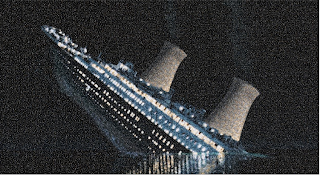Tuesday, March 26, 2013
abstract
Abstract art uses a visual language of form, color and line to create a composition which may exist with a degree of independence from visual references in the world.
Nonobjective art is another way to refer to Abstract art or nonrepresentational art.
Nonrepresentational Art is another way to refer to Abstract Art. These artworks do not represent or depict a being, a place or a thing in the natural world.
Abstract expression-stic movement of the mid-20th century comprising diverse styles and techniques and emphasizing especially an artist's liberty to convey attitudes and emotions through nontraditional and usually nonrepresentational means
Friday, March 8, 2013
chris jordan
Depicts 67,000 mushroom clouds, equal to the number of metric tons of ultra-radioactive uranium/plutonium waste being stored in temporary pools at the 104 nuclear power plants across the U.S. These waste pools must be cooled with hundreds of thousands of gallons of constantly circulating water, and many plants have inadequate or nonexistent backup cooling systems in case of power loss. In the U.S. and around the world, the waste pools are under-protected, over-filled, and vulnerable to earthquakes, storms, malfeasance, and human error. In 1997 the Brookhaven National Laboratory estimated that a calamity at just one of these waste pools in the U.S. could cause 138,000 American deaths (more than the number of Japanese who died in the 1945 bombing of Hiroshima), and contaminate 2,000 square miles of our land.
Currently, the waste pool in Reactor Unit 4 at Japan’s Fukushima-Daiichi plant is at risk for collapse. The building is unstable, and the cracked and leaking pool contains 262 tons of ultra-radioactive uranium/plutonium waste. For months, Fukushima has been experiencing numerous earthquakes from magnitude 4.1 to 6.2, sometimes several per day. If a magnitude 7 earthquake were to occur, causing the Unit 4 waste pool to rupture and drain, the resulting meltdown and fires could release ten times more airborne radioactive material than was released by the Chernobyl disaster. At that point humans could no longer enter or operate the facility, potentially leading to a chain reaction of meltdown events at Fukushima’s five other units, releasing 85 times as much radiation as the Chernobyl disaster.
The United States lies downwind of Fukushima, only a few days across the Pacific via the jet stream. The jet stream would carry radioactive material into the interior of the United States, eventually circling the globe and reaching the entire northern hemisphere within weeks or months. The amount of radiation released “would destroy the world environment and our civilization,” according to Robert Alvarez, former Senior Policy Adviser for National Security and the Environment at the U.S. Department of Energy.
Depicts 92,500 agricultural plant seeds, equal to one hundredth of one percent of the number of people in the world today who suffer from malnutrition. To illustrate the entire statistic with 925 million seeds would require ten thousand prints of this image, covering more than eight football fields.
Depicts 240,000 plastic bags, equal to the estimated number of plastic bags consumed around the world every ten seconds.

Depicts 200,000 packs of cigarettes, equal to the number of Americans who die from cigarette smoking every six months. Based on a painting by Van Gogh.
Depicts 50,000 plastic bags, equal to the estimated number of pieces of floating plastic in every square mile in the world's oceans.
Monday, March 4, 2013
homework high speed
i like these five photos for a few different reasons. One reason i like these pictures is because they make the photo look real. Also because these pictures are colorful, and catch the main detail of the photo. Also the photos are up close and detailed which makes me like these pictures.
Subscribe to:
Comments (Atom)





























